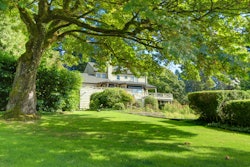 Photo: Pexels
Photo: PexelsIf you’ve considered adding mosquito control to your offered services for this year, it’s important to make sure you know the best practices when it comes to this business niche.
“This is one of the fastest growing segments in the lawn care and pest control markets,” says Dr. Kurt Vandock, head of public health for Bayer Environmental Science. “I would say the demand is there and it’s being driven by homeowners and commercial property owners.”
Mosquitoes are the deadliest animal in the world, responsible for three quarters of a million deaths a year thanks to the diseases it spreads, such as West Nile virus, dengue, chikungunya and Zika virus.
As both residential and commercial customers request this service out of concern over diseases and a desire for a pest-free environment, here are some the most effective practices out there.
Best practices
The most important best practice, according to Vandock, is the implementation of good integrated pest management (IPM).
This starts first with an inspection of the property. Vandock says you should look for standing water, which is a mosquito breeding site, environmental conditions that are conducive to mosquito control, as well as things you might not be able to control.
“For example, if there’s a clogged gutter, that’s something that unless you have a contract to clean that person’s gutter, you’re just not going to be able to fix but it’s just going to breed a ton of mosquitoes,” he says.
Vandock says the second part of the inspection is educating your customers and let them know how they can proactively remove mosquito breeding grounds, such as picking up kids’ toys that may collect standing water.
“I think one of the most important parts of good IPM is educating the homeowner that there are some situations where you simply will not be able to eradicate every single mosquito,” Vandock says. “We see a lot of companies promise 100 percent reduction in mosquitoes and that simply isn’t realistic because mosquitoes are flying pests. Some can fly miles.”
The third step is to apply effective and biologically efficacious barrier treatments. Vandock says this would be a residual barrier spray that’s applied to non-flowering foliage, as mosquitoes rest on the underside of leaves predominantly.
He says the best way to apply this residual barrier is with a backpack mist blower. He suggests using Bayer’s Suspend Polyzone for residual barrier treatments.
The final step is to apply larvicide, if appropriate.
“One thing you never want to do, and I want to stress this, is apply larvicides and adulticides together, because adulticides are pyrethroids and it’s illegal to put them in water,” Vandock says. “Also, larvicides that are applied with adulticides are a waste because the idea is that the mosquito carries the larvicide to a breeding site. Some companies say you should combine these two things together, and you really shouldn’t. The reason number one is it opens up LCOs to some liability issues because if a pyrethroid goes in water it’s a federal label violation for all pyrethroids. But the second reason you shouldn’t is if you have an effective adulticide, then it kills the mosquito and the mosquito couldn’t carry the adulticide to a breeding site to begin with.”
Vandock stresses that following the label and not spraying blooming plants or applying adulticides near areas of water helps protect non-target organisms and pollinators.
When it comes to best practices for residential versus commercial properties, Vandock says it depends on the size of the area you are trying to treat.
“If you’re doing anywhere from an eighth of an acre to five acres, you’re going to find that barrier treatments are effective and using a backpack mist blower, albeit scalable as the acres increase it takes more time on the ground to make the application, is the best way to do it,” he says.
When you get anywhere from 10 to hundreds of acres to treat, say for an HOA or a golf course, you need to change your tactics in order to be efficient.
“The solution there is to resort to tactics that are employed by public mosquito control,” Vandock says. “That’s using wide area space sprays. These are non-residual products applied via ultra-low volume.”
Vandock says depending on the equipment that you use, you can treat hundreds of acres per hour, allowing you to treat neighborhoods, golf courses, recreational facilities and even cities.
“About 10 years ago, public funding was significantly restricted and then they cut to public mosquito control,” he says. “When they did, it really created an opportunity for the private sector.”
Another best practice is to test different products to see how well they work as organic versus synthetic products have different levels of scrutiny applied.
“I would encourage everyone to try all products, including Bayer products, before adopting one,” Vandock says. “I think that the efficacy, as will be noted by customer callbacks, in this case with the landscapers will give you an idea of which products are working best so don’t trust me, trust the trial.”
Common pitfalls
The two main pitfalls landscapers can experience when offering mosquito control services are trying to utilize ineffective equipment and not setting customer expectations.
“A power spray rig is not the right piece of equipment for applying a barrier treatment for mosquito control,” Vandock says. “The reason for this is because a power sprayer is going to apply the product in large droplets to the tops of leaves and while this may be effective for ornamental treatment or lawn treatment, it’s not effective for applying the product to the underside of leaves.”
Mosquitoes prefer the shade, as they desiccate rapidly in the sunlight, so the only way to get a product on the underside of something is to make the droplets smaller and apply them at a high velocity with equipment like a backpack mist blower.
The other major mistake that can be made is not setting appropriate customer expectations.
“To have a customer expect that 10 minutes after you’ve made your application and left that they will see no mosquitoes is a giant pitfall,” Vandock says. “Mosquitoes are flying pests and you have sprayed a surface. That doesn’t mean every mosquito in the environment is now immediately eradicated.”
Because you can’t spray all surfaces due to blooming plants, or not having a license to spray structures, not all the available resting sites for mosquitoes are treated. This means that it will take time for a mosquito to land on a treated surface and die. It could take one day or five days before there is a noticeable difference depending on various factors.
“If you get a call back four hours after the application is made, talking to customers through how long it takes to control mosquitoes is a great way to retain that customer, set good expectations and most importantly, demonstrate your expertise,” he says.










